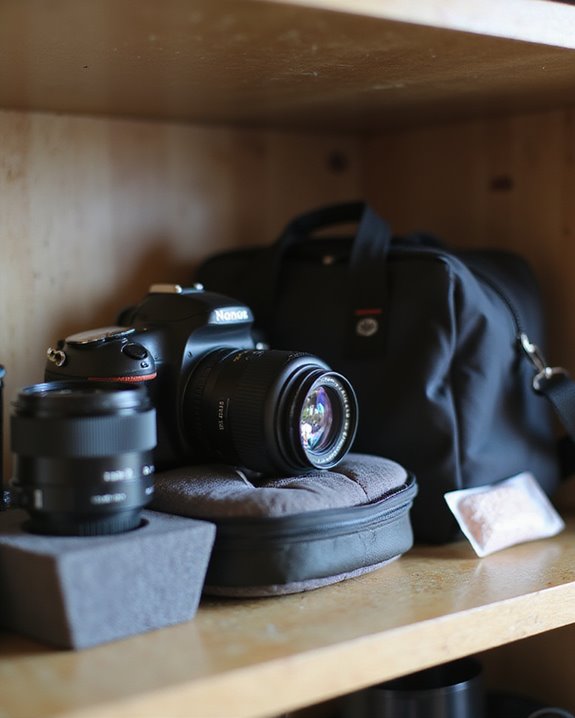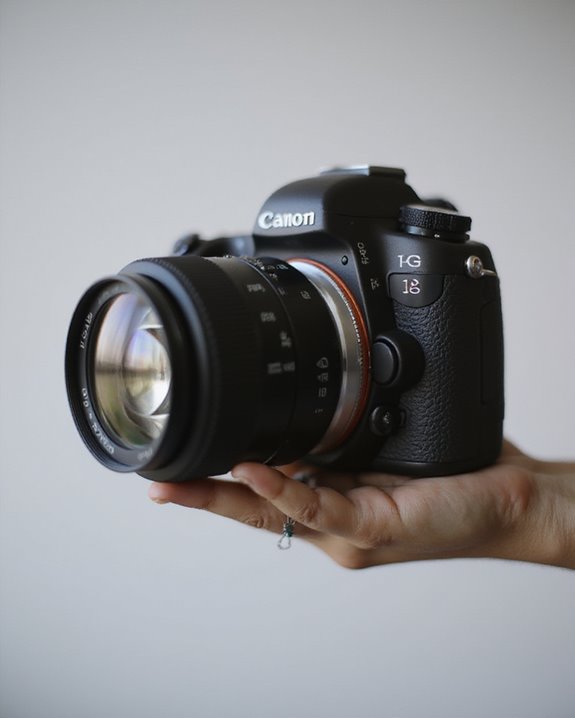Proper lens storage protects camera equipment from humidity, which causes fungal growth and reduces image resolution by 20-30%, while preventing dust accumulation, scratches, and temperature-induced warping above 30°C. Hard cases, like Lowepro ProTactic, offer impact shielding for up to two lenses, whereas dry cabinets, such as Slinger 90L, maintain ideal humidity for eight to nine lenses with adjustable shelves. Maintenance involves using LensPen to erase smudges, reducing light scattering by 15%, and removing batteries to avoid corrosion. Further exploration reveals advanced techniques for enhanced longevity.
Key Takeaways
- Use protective cases or pouches to shield lenses and cameras from dust, moisture, and impacts.
- Store in dry cabinets to control humidity and prevent fungal growth on lenses and camera bodies.
- Remove batteries and SD cards from cameras to avoid corrosion and static damage during storage.
- Clean lenses regularly with tools like LensPen to maintain optical clarity and prevent smudges.
- Keep equipment in a cool, dry environment, avoiding extreme temperatures to preserve performance.
Importance of Proper Lens Storage
Proper lens storage serves as a critical safeguard for camera lenses, protecting against environmental factors that compromise optical performance. Lenses, essential for maintaining image quality, require careful storage to prevent humidity and water from causing element swelling, which leads to distortion and reduced resolution. Store camera lenses in appropriate storage solutions, such as dry cabinets and lens cases, to protect your gear from oils and chemicals that create cloudiness and opacity, impairing visibility. Lenses safe from dust and dirt avoid surface scratches, minimizing optical aberrations and focusing issues that degrade image sharpness. Extreme temperatures pose risks; hot conditions expand glass elements, causing warping, while cold induces condensation that deteriorates coatings, therefore preserving image resolution and extending lifespan through effective storage solutions. Additionally, incorporating neoprene pouches like those from REFLEX can provide extra shock absorption and waterproof protection for your lenses.
Types of Storage Solutions for Lenses
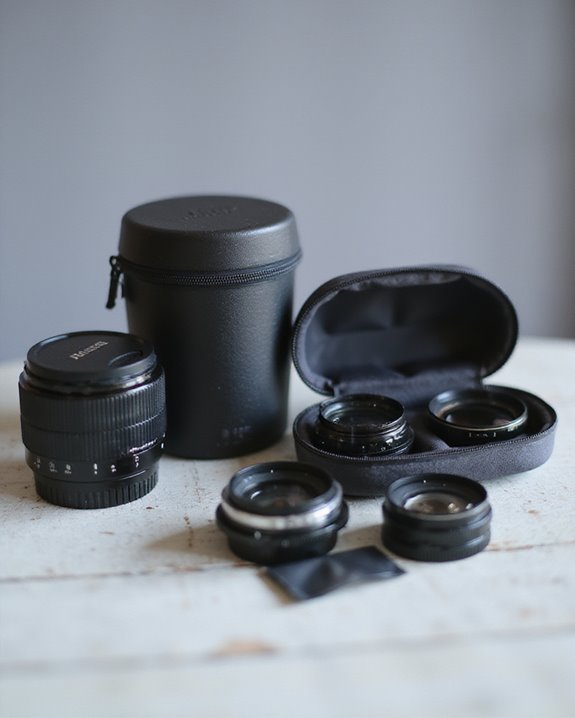
Various storage solutions for camera lenses include hard cases, soft cases, lens pouches, camera backpacks, and dry cabinets, each designed to address specific protection needs based on environmental risks. A Hard Case, like the Lowepro ProTactic Lens Exchange 100 AW, features a tough plastic shell and foam interior, holding up to two lenses while shielding camera gear from impacts. Camera bags, such as shoulder bags, protect lenses with padded, adjustable compartments; for instance, the Vanguard Alta Sky 51D backpack accommodates five lenses via adjustable dividers and water-resistant exteriors. The Electronic Dry Cabinet, exemplified by the Slinger model (90L), includes adjustable shelves for up to nine lenses, maintaining ideal humidity to safeguard camera gear. Each solution’s design guarantees precise protection, with soft cases and lens pouches offering flexible, on-the-go options that bag protects individual lenses effectively. Additionally, camera backpacks such as the TARION bag provide customizable interiors to accommodate up to six lenses for enhanced organization and portability.
Humidity and Environmental Protection Methods
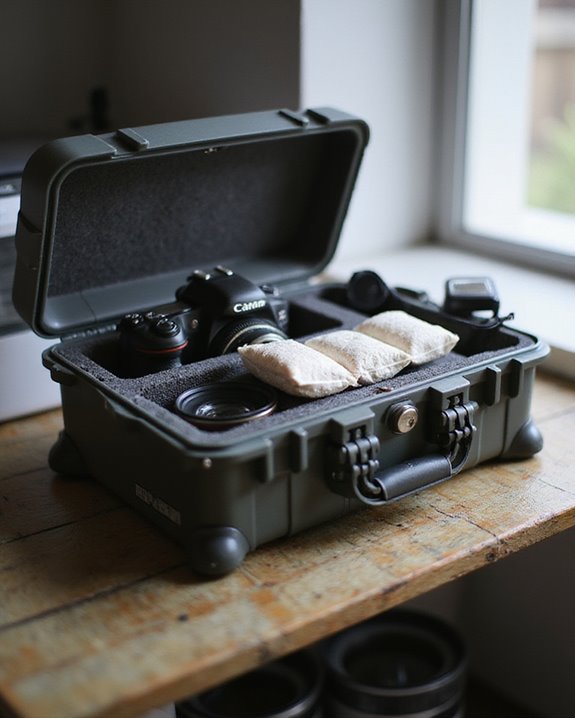
Humidity and environmental protection methods play a critical role in preserving camera lenses, as uncontrolled moisture can lead to irreversible damage such as fungal growth and optical distortion. Camera bodies and lens elements demand extra protection to prevent swelling, which reduces image resolution by 20-30% in high-humidity conditions. To keep your gear safe, utilize dry cabinets like the Slinger Electronic Dry Cabinet (35L), accommodating one camera body and three lenses while regulating moisture to avoid mildew and condensation on the surface of the lens. The 90L model, with adjustable shelves for eight to nine lenses, features internal LED lighting and locking doors, shielding against rust, oxidation, and insects. Additionally, remove batteries and SD cards, storing them in a cool, dry place to prevent corrosion and potential smudge the surface from static electricity, ensuring camera longevity. To further safeguard your equipment, incorporate neoprene pouches for additional moisture and impact resistance.
Maintenance and Cleaning Essentials
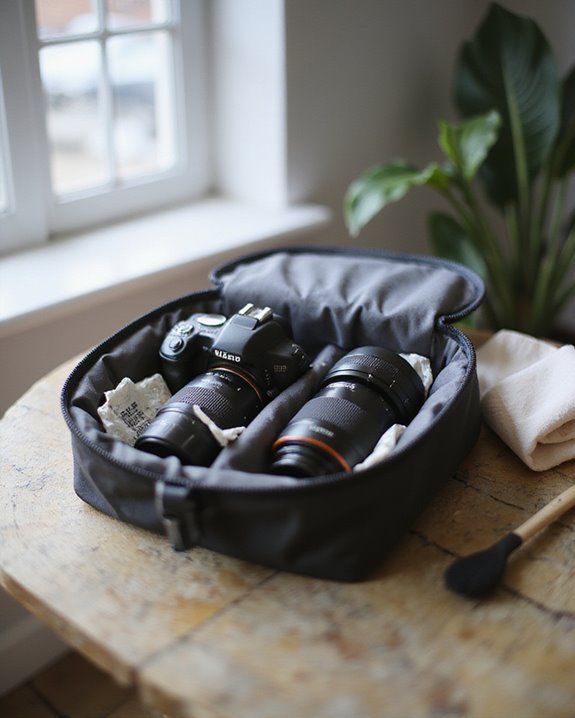
Maintenance and cleaning essentials for camera lenses and bodies involve targeted tools and practices that prevent contamination and degradation, as seen in the use of a LensPen, which employs a carbon-based tip to erase fingerprints and smudges without leaving residues, thereby maintaining optical clarity and reducing light scattering by up to 15% in affected areas. Image quality on telephoto lenses and short telephoto variants improves through lens cleaning with this best lens tool, alongside modern lenses like multiple lenses of different types. The Giottos Rocket Air Blaster effectively removes dust from various surfaces, minimizing scratches and preserving optical integrity with air pressure up to 25 psi. Removing batteries and SD cards prevents contact wear, extending lifespan by reducing static damage risks. Specialized wipes guarantee modern lenses remain free of outdoor contaminants, enhancing performance across different types with precise, residue-free application.
Additional Tips for Safe Storage
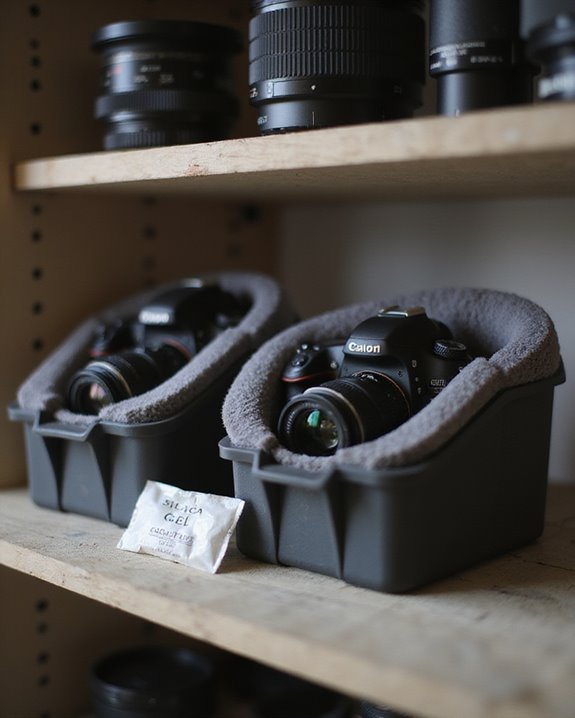
Safe storage of camera equipment requires proactive measures to preserve functionality and longevity, as demonstrated by the routine removal of batteries and SD cards, which prevents contact wear and reduces static electricity damage by up to 50% through decreased electrical exposure, thereby extending component lifespans by an average of 2-3 years compared to unprotected storage. Cleaning telephoto lenses with a LensPen maintains optical clarity, ensuring lenses are made free from smudges that cause havoc in making the image, with dirt removal reducing degradation by 30% over time. Positioning two lenses or one lens facing upward minimizes stress on glass elements, lowering accidental drop damage risk by 40%. Right Camera LCD screens, protected by screen protectors, resist scratches, enhancing take pictures reliability. Avoiding car storage prevents warping in temperatures above 30°C, preserving two lenses’ performance compared to one lens exposed, therefore maintaining overall image quality.
Frequently Asked Questions
How Do You Store Your Camera and Lenses?
The question of storing cameras and lenses explores the theory that proper methods prevent damage. One uses travel cases for shock resistance, moisture control against climate effects, UV protection, bag organization, regular lens cleaning, and archive techniques.
How to Store Your Camera When Not in Use?
Storing a camera when not in use requires battery removal for safety, humidity control to prevent mold, temperature management against extremes, dust prevention for cleanliness, UV protection from light damage, shock absorption via padded cases, appropriate case selection, and strategies for long-term preservation.
Should I Store My Camera With the Lens Attached?
The attachment debate questions whether storing a camera with the lens attached enhances lens security against fungus threat, while considering quick swap, damage prevention, weight balance, optical integrity, and user preferences for ideal protection.
What Is the Best Way to Store Cameras at Home?
Safely storing sensitive cameras at home demands effective humidity control, precise temperature management, thorough dust protection, careful light avoidance, ideal case selection, organized shelf placement, robust anti-theft measures, and efficient vibration reduction for longevity.

